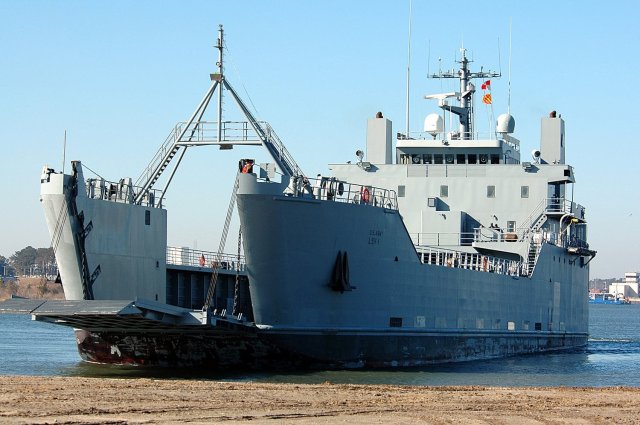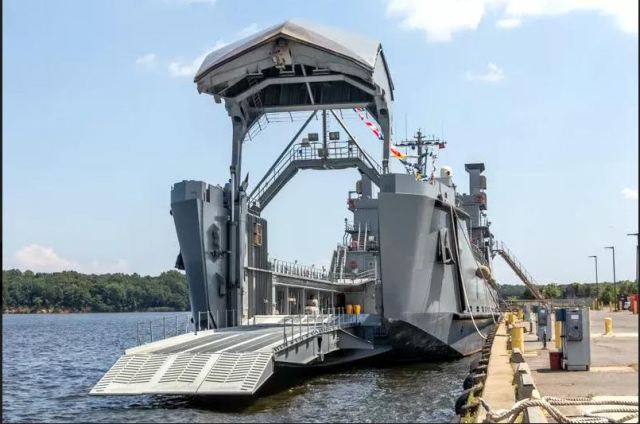As reported by the Israeli web resource israelhayom.co.il and a colleague olegranovsky, the Israeli Ministry of Defense, without publicity, ordered two new landing ships ("Nahatot") designated as LSV (Logistic Support Vessel) for the Israeli navy in the United States. Presumably, we are talking about ships similar to the General Frank S. Besson-type LSV amphibious assault ships belonging to the US Army.

The lead amphibious transport ship LSV-1 General Frank S. Besson of the US Army (c) of the US Navy
Eight LSV amphibious assault ships of the General Frank S. Besson type were built specifically for coastal and inter-island transportation of the US Army from 1987 to 2007 at the shipyard VT Halter Marine (formerly Halter Marine, since 2003 under the current name belongs to the Singapore company ST Engineering) in Pascagoula (Mississippi). The first six ships of this type, commissioned in 1987-1994 (LSV-1 - LSV-6), have a total displacement of 4266 tons, a length of 83 m and a width of 18 m. The two-shaft power plant includes two EMD 16-645E2 diesel engines with a capacity of 1950 hp each, providing a full speed of 12.5 knots empty and 11.5 knots in full load. The cruising range in full cargo is 6,200 miles. Architecturally, the ships are typical large amphibious ships of the traditional type with fore and aft cargo ramps, with the ability to move equipment under their own power along the entire length of the cargo hold and the possibility of landing it on an unequipped coast. The cargo deck of the ship is designed for any equipment available in the US Army, and can carry up to 15 M1 Abrams tanks or 82 ISO containers. The total cargo capacity of the ship is up to 2280 tons. The crew is 31 people, staffed by reservists.
The last two ships of this type LSV-7 SSGT Robert T. Kuroda and LSV-8 Major General Robert Smalls were commissioned by the US Army in 2005 and 2007 and are characterized by increased dimensions, having a total displacement of 5,400 tons and a length of 96 m, as well as a 25% more powerful power plant. These two ships, with the same cargo capacity as the first six ships of this type, have a modified bow ramp design with an upward part to improve seaworthiness and are additionally equipped with powerful incinerators and desalination plants.
In addition, two ships similar to the first six LSV type ships were built in the 1990s as amphibious assault ships for the Philippine Navy (Bakolod type). They differ in the presence of a helicopter pad and defensive weapons.
It is unclear which specific modification of the LSV ship is being built for the Israeli Navy. It is reported that ships for Israel are already being built at an unnamed American shipyard (apparently, the same VT Halter Marine). The first ship is due to arrive in Israel "in a few months" (according to other sources at the beginning of 2023), the second - two months later. The Israeli Navy has been preparing for the acceptance of these ships for a long time, they will be part of a new division ("Palga"), recently formed at the Ashdod naval base. It is also known that after arriving in Israel, the ships will receive a number of Israeli systems, their installation and testing will take several months.
The Israeli Navy has not had amphibious forces since the mid-1990s, when all small amphibious ships and amphibious boats were decommissioned from their composition, and only in 2011-2012 three small 50-ton 23-meter Manta-type amphibious boats of Singapore construction (project BRAVE-18T, carrying capacity 18) were purchased for the Israeli navy. tons). Now, with the receipt of essentially two large amphibious assault ships, Israel's amphibious capabilities will increase dramatically.

LSV-8 Major General Robert Smalls US Army amphibious transport ship with an open bow ramp. Charleston, 03/16/2021 (c) Gavin McIntyre
